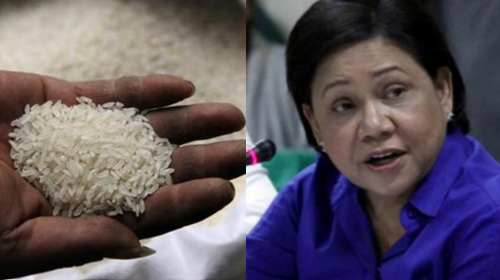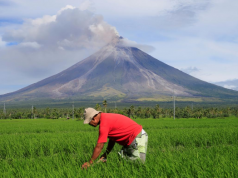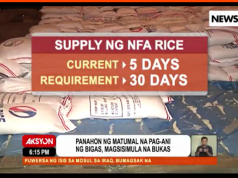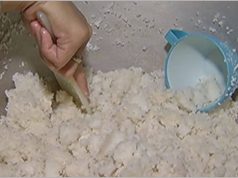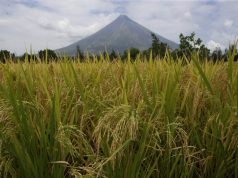MANILA, Philippines – After setting social media ablaze with her call to ban the offering of unlimited rice servings, Sen. Cynthia Villar on Thursday backpedalled and said she had no intention of legislating her concern on the health risk of eating too much of the staple.
“I am not planning to make a law banning ‘unli rice,’ not at all. I just voiced out my concern that eating too much rice is one of the main causes of high blood sugar that leads to diabetes,” the senator said.
“But, of course, I cannot prevent people from eating unlimited amount of rice. It is their choice. It was just a genuine expression of concern on my part,” added Villar, chairperson of the Senate Committee on Agriculture and Food.
She cited that in other countries, they promote a balanced diet consists of a small portion of rice and a generous amount of vegetables.
“In schools in Japan, the students even discuss the nutritional value of their meals for the day before they eat. They also harvest the vegetables they eat from the garden in their school. Of course, we want our children and children’s children to grow up healthy,” added Villar.
Many Pinoy netizens didn’t take lightly Villar’s position against eating too much rice and calling food establishments to encourage people to eat more vegetables for them to have a healthier diet.
Some claimed that the senator, the richest lawmaker in the Senate, was being insensitive to the plight of the poor, who frequently eat more rice with less viand or at times even without viand to beat hunger pangs.
“I don’t understand the issue abt #UnliRice.What’s wrong with that? These are budget meals for simple workers who earn just enough or not much,” said netizen meg.arao.
“Want healthier Filipinos? Don’t ban people’s unli-rice. Ban politicians’ unli-pork,” said another netizen John Hendrix.
Poverty, eating rice: What’s the link?
Meanwhile, others who are experts in food security issues stressed that eating more rice is not primarily a choice but is mainly linked to a consumer’s purchasing power and thus, if seen as a problem, needs more comprehensive solutions and not just making calls for restaurants to stop offering ‘unli’ rice to Filipino consumers.
A study done by the Philippine Rice Research Institute (Philrice) titled Rice Science for Decision-Makers: Why Is Per Capita Rice Consumption Increasing? pointed out that the increasing population of poor Filipino families has something to do with the increase in the consumption of the staple.
“(T)he lower classes and rural people spend more on rice and have higher PCRC (per capita rice consumption than the upper classes and the urban people. Poor families eat more rice than the middle- and higher-income families,” the study noted.
In another study published in 2013 titled Estimating the Demand Elasticities of Rice in the Philippines, the Southeast Asian Regional Center for Graduate Study and Research in Agriculture (SEARCA) also pointed out the relation of the economic status of consumers to their rice intake.
“The primary consumers of rice are the poorer sector of the economy, particularly the rural poor. Their diet is predominantly based on rice, which they consider a very basic food item in their food baskets,” SEARCA said.
“While this is also true for the rich consumers, unlike the poor, however, the more affluent consumers have more diverse food baskets as they consume more of other luxury foods like fish, meat, fruits, and vegetables,” it noted.
“Their limited purchasing power to buy enough rice as well as other supplementary foods for their family worsens, resulting in malnutrition, food insecurity, and poverty,” the organization further pointed out.
Improve purchasing power
SEARCA said that “theoretically,” if the government wants Filipinos to decrease its consumption, it could do so by “substantially” increasing the price of the staple “so that it would become less affordable to the consumers, especially to the poor consumers, who are the major consumers of rice.”
However, it said this measure “is not feasible in reality because such a strategy will certainly worsen food insecurity, hunger, and malnutrition in the country.”
SEARCA said a “more plausible strategy is to implement differential policies that can effectively reduce rice consumption but, at the same time, will not hurt the consumers, particularly the poor.”
“Any policy that will improve the purchasing power of the targeted consumers, primarily through price-related or income-related policies, is expected to lead to a decline in rice consumption of consumers and diversification of their diet in favor of other commodities,” it said.
In past media interviews, food security experts also stressed the link between weak purchasing power and eating more rice.
“Rice is still cheap. Para mabusog, magkanin na lang [To get full, just eat rice],” said former Philrice chief Efraim Rasco in a media interview in 2011.
Also, Rolando Dy, an economist at the University of Asia and the Pacific, earlier explained that rice consumption tends to go down as income goes up.

